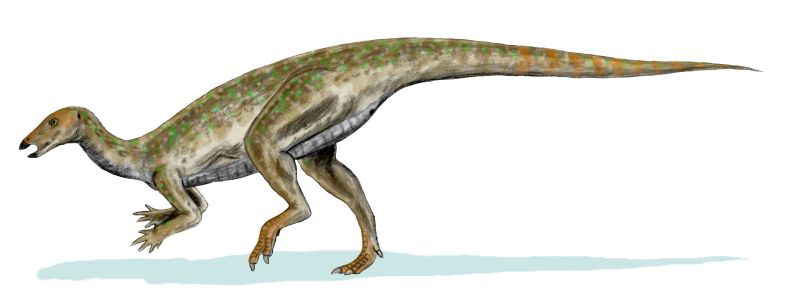Beneath the ancient sands of Mongolia’s Gobi Desert lies the story of one of the most heavily armored dinosaurs ever to walk the Earth. Saichania chulsanensis, whose name fittingly means “beautiful one” in Mongolian, was a remarkable ankylosaur that roamed the arid landscapes of Central Asia during the Late Cretaceous period, approximately 80-75 million years ago. This tank-like herbivore combined defensive excellence with surprising adaptations for its harsh environment, making it one of paleontology’s most fascinating subjects. Discovered during the 1970s, Saichania continues to provide scientists with valuable insights into dinosaur evolution, defense mechanisms, and survival strategies in challenging habitats.
Discovery and Naming
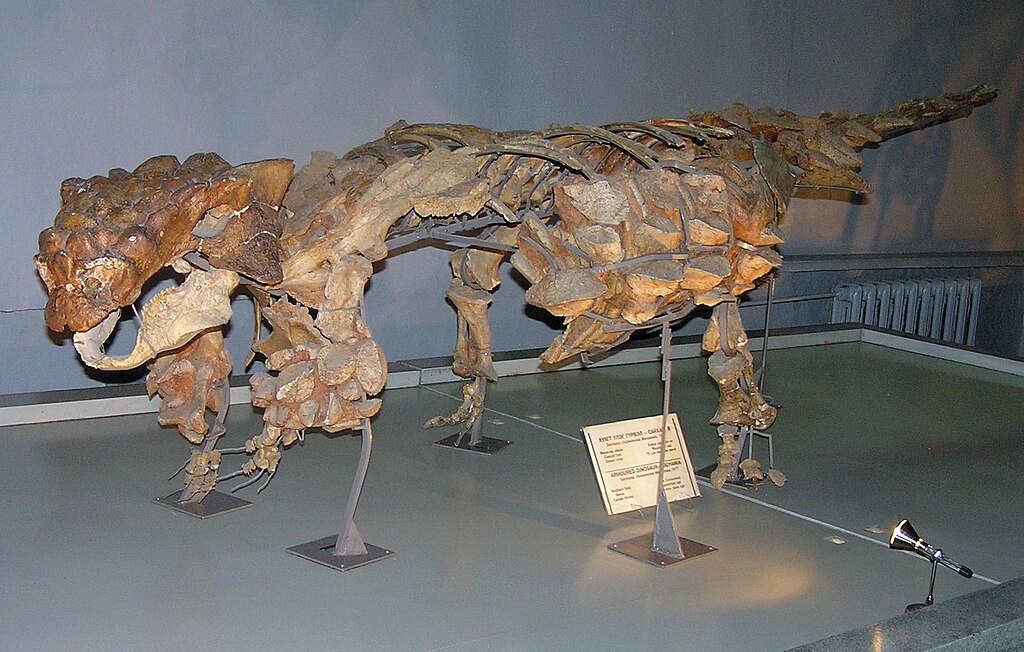
Saichania was first unearthed during the Soviet-Mongolian Paleontological Expeditions to the Gobi Desert in the 1970s. The holotype specimen, consisting of a remarkably well-preserved skull and partial skeleton, was discovered in 1977 in the Barun Goyot Formation of southern Mongolia. Renowned paleontologist Tatyana Tumanova formally described and named the dinosaur in 1977, choosing the name “Saichania” which translates to “beautiful one” in Mongolian, referencing its exceptionally well-preserved condition. The species name “chulsanensis” refers to Khulsan, the region in Mongolia where the fossil was discovered. This initial discovery provided paleontologists with critical insights into ankylosaur anatomy, particularly regarding its skull structure and body armor, which were preserved in unusually complete condition.
Classification and Evolutionary Context

Saichania belongs to the family Ankylosauridae within the broader group Ankylosauria, a diverse clade of heavily armored, herbivorous dinosaurs. Within this family, Saichania is specifically classified as a member of the Ankylosaurinae, representing one of the most derived and specialized ankylosaurs. Its closest relatives include fellow Asian ankylosaurs like Tarchia and Pinacosaurus, together forming a distinct evolutionary branch that thrived in the Late Cretaceous ecosystems of Central Asia. Saichania represents the culmination of ankylosaur evolution, displaying highly developed defensive features that had been refined over millions of years. The fossil record suggests that ankylosaurs like Saichania were among the last dinosaur groups to diversify before the end-Cretaceous extinction event, showing how successful this heavily-armored body plan had become in dinosaurian evolutionary history.
Physical Characteristics

Saichania was a medium-sized ankylosaur, measuring approximately 5-7 meters (16-23 feet) in length and weighing an estimated 2-4 tons. Its most distinctive feature was its incredibly robust armor, consisting of bony plates called osteoderms embedded in the skin across its back, sides, and tail. The dinosaur’s low-slung body was wide and flattened, providing a stable platform that would have been difficult for predators to overturn. Saichania’s skull was particularly heavily reinforced, with thick bone protecting the brain and sensory organs. The head featured complex nasal passages that may have helped it survive in arid environments by conserving water from exhaled breath. Unlike some of its relatives, Saichania’s tail club was relatively modest in size, though still formidable enough to serve as an effective defensive weapon against predators like Tarbosaurus, the Asian relative of Tyrannosaurus rex.
The Armored Defense System
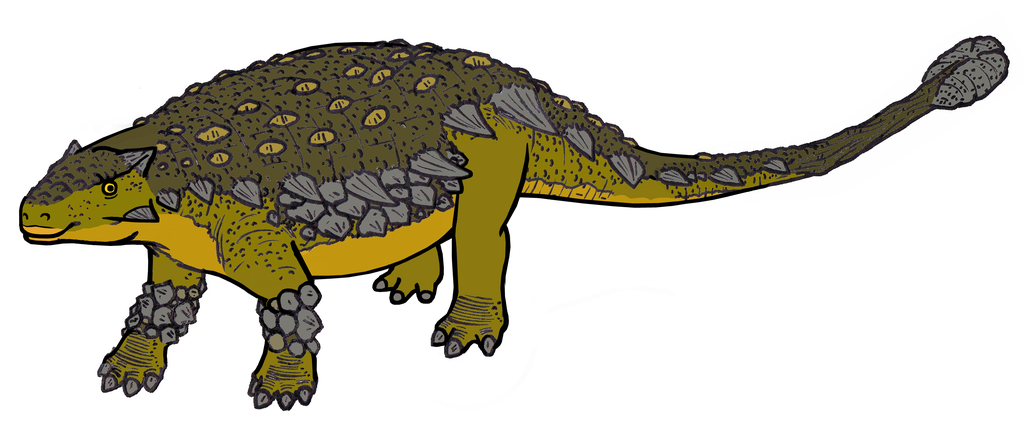
Saichania’s defensive armor represents one of the most sophisticated protection systems ever evolved by a terrestrial vertebrate. Its body was covered in hundreds of osteoderms varying in size and shape, creating a mosaic of protective plates that effectively shielded it from predatory attacks. Larger, keeled scutes lined the flanks, while smaller, flatter ossicles filled the spaces between them, creating a nearly impenetrable external surface. The shoulder region featured particularly large, spike-like projections that would have deterred attacks from the sides. This armor wasn’t simply a passive shield – the arrangement of the plates allowed for some flexibility while maintaining protection, balancing defensive needs with mobility requirements. The defensive structure was completed by half-rings of armor protecting the neck, a vulnerable area that many predators would typically target. This comprehensive armor system meant that even large predatory dinosaurs would have found attacking an adult Saichania to be an extremely challenging and potentially dangerous proposition.
Advanced Respiratory Adaptations

One of Saichania’s most remarkable and unique features was its complex nasal structure, which represented a sophisticated adaptation to its arid environment. The dinosaur possessed elaborate nasal passages that formed a convoluted maze-like structure within its skull. These passages likely served multiple functions critical to desert survival. Primarily, they would have acted as moisture-recapturing systems, trapping water vapor from exhaled breath and returning it to the body, thereby reducing water loss – a critical adaptation for life in the dry Gobi Desert. Additionally, these passages may have functioned as air filters in the dusty environment, trapping particles before they could reach the lungs. Some paleontologists suggest that these chambers might have also played a role in thermoregulation, cooling inhaled air before it reached the brain and lungs. These respiratory adaptations demonstrate that Saichania wasn’t just well-defended against predators, but also physiologically adapted to thrive in harsh environmental conditions.
Diet and Feeding Habits
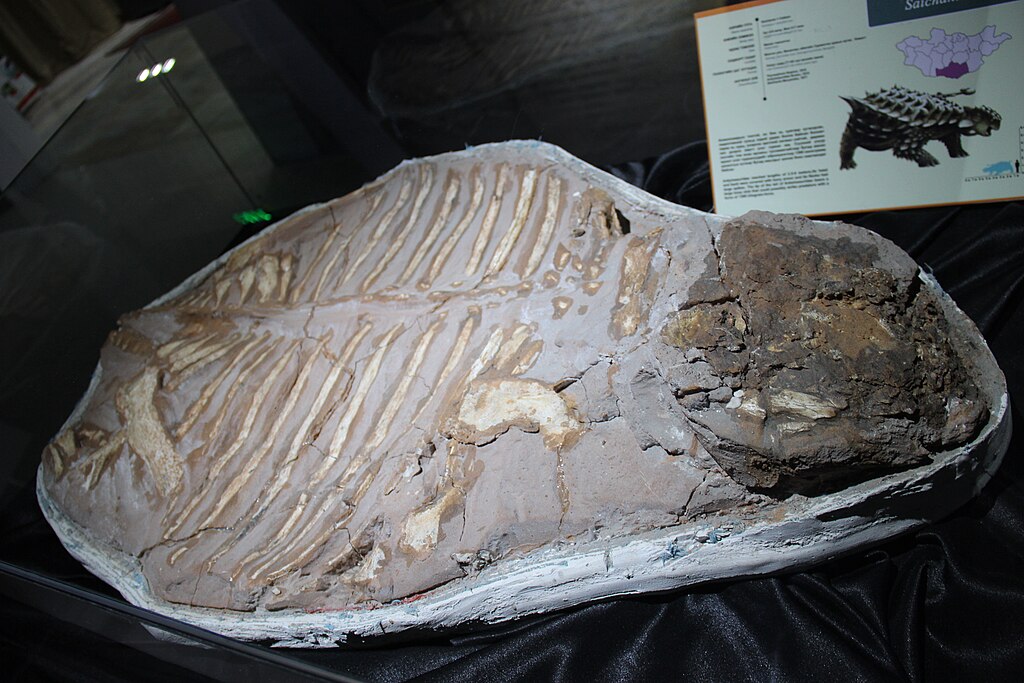
Saichania was a committed herbivore with specialized adaptations for processing tough vegetation found in its semi-arid habitat. Its narrow, beaked mouth was ideal for selective feeding, allowing it to pluck specific plants while avoiding less nutritious or potentially toxic vegetation. Behind this beak were rows of small, leaf-shaped teeth suited for shearing plant material rather than grinding it. Unlike many other herbivorous dinosaurs that processed food through extensive chewing, Saichania likely relied more on gut fermentation to break down plant matter. Its low-slung posture meant it primarily fed on low-growing vegetation, possibly including drought-resistant shrubs, ferns, and cycads that could survive in the challenging Gobi environment. The dinosaur’s wide body would have allowed for an extensive digestive tract capable of processing fibrous plant materials efficiently. This dietary specialization enabled Saichania to exploit food resources that many other contemporary herbivores would have found difficult to digest, giving it a competitive advantage in its ecosystem.
The Gobi Desert Habitat
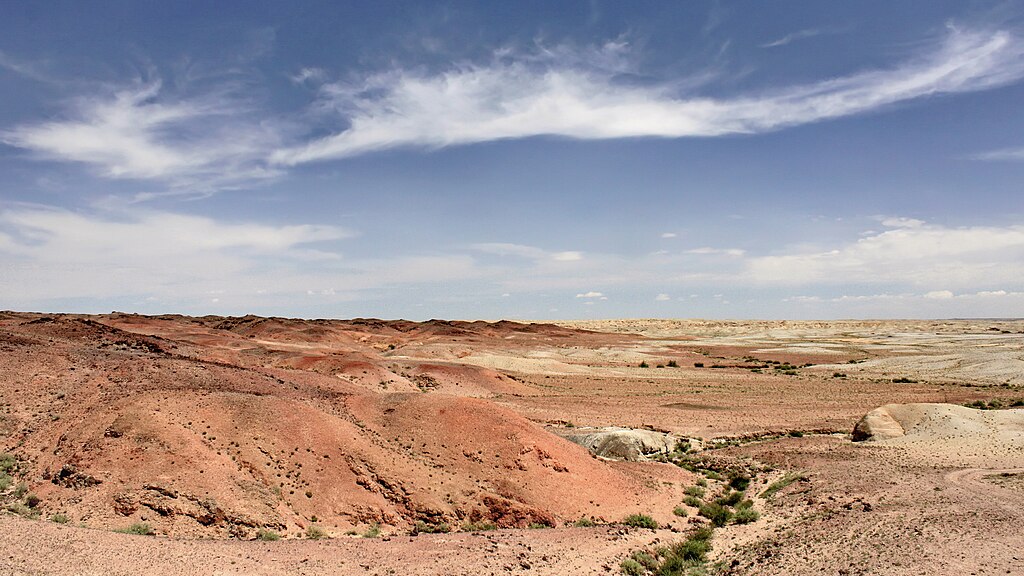
During the Late Cretaceous period, the Gobi region where Saichania lived was significantly different from today’s desert, though still relatively arid. Paleoenvironmental evidence suggests it was a semi-desert ecosystem characterized by seasonal streams, scattered oases, and sand dune fields. The climate featured distinct wet and dry seasons, creating a challenging environment that required specialized adaptations from its inhabitants. Vegetation was likely sparse and dominated by drought-resistant plants such as conifers, ginkgoes, ferns, and various early flowering plants. This habitat was prone to periodic dust storms and sand deposition, as evidenced by the excellent preservation of many fossils in what appear to be sudden burial events. The Barun Goyot Formation that yielded Saichania fossils indicates an inland, continental environment with streams that periodically flooded, creating temporary wetlands. These environmental conditions shaped Saichania’s evolution, contributing to its specialized respiratory system and feeding adaptations that allowed it to thrive where other large herbivores might struggle.
Social Behavior and Lifestyle

While direct evidence of Saichania’s social behavior remains limited, paleontologists can make reasonable inferences based on related ankylosaurs and the constraints of its environment. Given its defensive adaptations and relatively slow movement, Saichania likely lived in small groups that provided additional protection through collective vigilance. Juvenile specimens suggest that young Saichania had less developed armor, potentially indicating they received parental protection or stayed within the safety of the herd until their defensive features fully developed. The challenging environment of the Gobi would have influenced movement patterns, possibly resulting in seasonal migrations following water availability or vegetation growth. Like modern large herbivores in resource-limited environments, Saichania groups likely maintained loose associations that could form or disband as environmental conditions changed. The lack of sophisticated dentition for extensive food processing suggests individuals spent significant portions of their day feeding to meet their metabolic requirements, with their armored bodies providing protection during these vulnerable periods.
Predators and Defensive Behavior

Despite its formidable armor, Saichania shared its ecosystem with dangerous predators capable of threatening even well-protected prey. Chief among these was Tarbosaurus bataar, a close relative of Tyrannosaurus rex and the apex predator of Late Cretaceous Mongolia. Other potential threats included smaller but pack-hunting dromaeosaurids like Velociraptor. When faced with these predators, Saichania’s primary defense was passive – its extensive body armor made it an unappealing target for most hunters. If directly threatened, it could likely hunker down close to the ground, tucking its less-protected underside away from attackers. For active defense, Saichania possessed a tail club that, while not as massive as some other ankylosaurs, could still deliver powerful blows to a predator’s legs or body. The dinosaur could swing this tail with considerable force, potentially breaking bones or discouraging continued attacks. Younger, less armored individuals may have relied more on staying within groups or using camouflage to blend into the semi-arid landscape, avoiding detection by predators altogether.
Growth and Development

Understanding of Saichania’s growth patterns stems from both direct fossil evidence and comparative studies with related ankylosaurs. Hatchling ankylosaurs were relatively small and vulnerable, with armor that developed progressively throughout their lives. Young Saichania likely possessed proportionally larger heads and eyes, with less extensive and less fused armor compared to adults. Growth rates in ankylosaurs appear to have been relatively rapid in early life stages, gradually slowing as individuals approached adult size. This growth pattern would have been advantageous in the harsh Gobi environment, allowing juveniles to quickly develop the defensive features necessary for survival. The fusion of various skull elements and the increasing complexity of armor would have occurred progressively during development, with full maturity possibly reached after several decades. Some ankylosaur specimens show evidence of arrested growth lines in their bones, suggesting that development might have slowed during particularly challenging seasons or years, a common adaptation for animals living in environments with fluctuating resource availability.
Comparison to Other Ankylosaurs
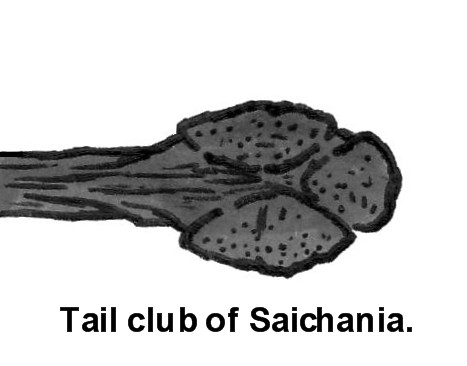
Saichania stands out among ankylosaurs for several distinctive features, even when compared to its close relatives. Unlike North American ankylosaurs such as Ankylosaurus and Euoplocephalus, Saichania possessed more elaborate nasal passages adapted for desert conditions, a specialization not seen to the same degree in its relatives from more temperate regions. Compared to its Asian cousin Tarchia, Saichania had a more heavily built skull but somewhat less massive tail club. Pinacosaurus, another Gobi ankylosaur often found in the same formations, was generally smaller with less robust armor, potentially representing a different ecological niche within the same environment. The Chinese ankylosaur Shamosaurus exhibits more primitive features than Saichania, lacking the elaboration of armor and nasal structures, highlighting Saichania’s position as one of the most derived members of the family. North American ankylosaurs typically had wider heads and larger tail clubs than their Asian counterparts, possibly reflecting different predator pressures or dietary adaptations across these regions.
Scientific Importance and Research History

Since its initial description by Tumanova in 1977, Saichania has remained a significant subject in paleontological research, offering crucial insights into ankylosaur evolution and adaptation. The exceptional preservation of the original specimens, including detailed skull anatomy and intact armor arrangements, has made it a reference point for understanding ankylosaur morphology. In the 1990s, detailed examinations of its nasal passages by paleontologists like Teresa Maryańska sparked new theories about ankylosaur physiology and environmental adaptation. The early 2000s saw renewed interest in Saichania with the discovery of additional specimens and advanced CT scanning techniques that revealed previously unknown details of its internal anatomy. More recent research has focused on the biomechanics of its armor and tail club, using computer modeling to understand their defensive capabilities. Ongoing fieldwork in Mongolia continues to yield new information about this dinosaur’s environmental context and relationship to other fauna of the late Cretaceous Gobi ecosystem, cementing Saichania’s role as a key species for understanding dinosaur adaptation to challenging environments.
Legacy in Popular Culture

While not as immediately recognizable as dinosaurs like Tyrannosaurus or Triceratops, Saichania has secured its place in paleontological education and popular media as the quintessential example of an armored desert specialist. The dinosaur has been featured in numerous museum exhibitions worldwide, often showcased as an example of extreme defensive adaptation. Detailed reconstructions of Saichania appear in major natural history museums in Mongolia, Russia, Japan, and Europe, highlighting its significance to Central Asian paleontology. In documentary series such as BBC’s “Planet Dinosaur,” Saichania has been portrayed battling against predators in its harsh desert environment, emphasizing its survival adaptations. The dinosaur has also found representation in educational books, dinosaur encyclopedias, and various paleontology-focused websites, where its unique nasal adaptations and armor configurations are frequently highlighted. Several toy companies and model makers have created Saichania replicas, bringing this fascinating Mongolian dinosaur to dinosaur enthusiasts of all ages and contributing to public understanding of the diversity of ankylosaur adaptations across different environments.
Conclusion
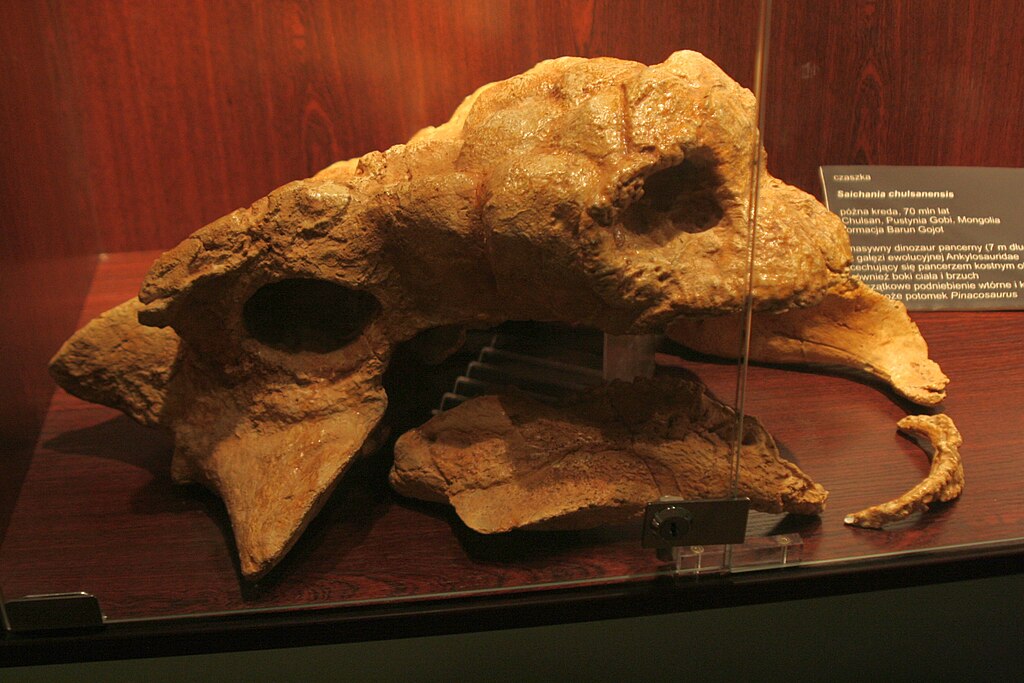
Saichania stands as a remarkable testament to evolutionary adaptation, combining exceptional defensive capabilities with specialized features for survival in a challenging semi-desert environment. From its intricate armor system to its sophisticated respiratory adaptations, this “beautiful one” of Mongolia represents one of nature’s most impressive solutions to the dual challenges of predation and environmental stress. As paleontological techniques continue to advance, Saichania’s remains offer an ongoing opportunity to deepen our understanding of how dinosaurs adapted to specific ecological niches during the Late Cretaceous period. The story of this well-armored desert dweller reminds us that dinosaurian success was built not just on impressive size or ferocity, but on specialized adaptations perfectly suited to their particular place in the ancient world.

